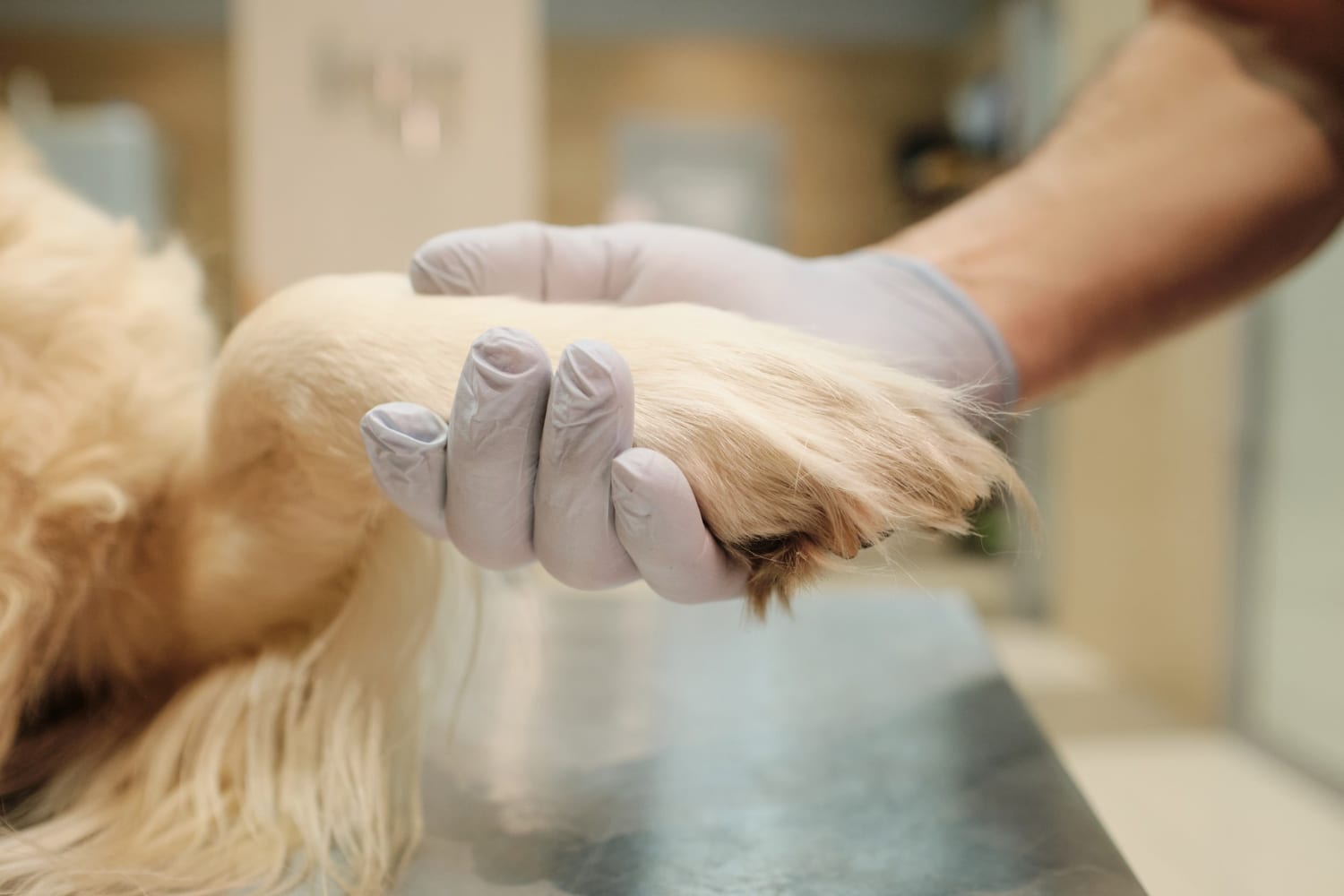Lungworm in Dogs: Signs and Prevention

By Evelyn Harcourt
June 03, 2025 - 1 min read
Canine lungworm infection is prevalent in the UK. While it was once largely restricted to the south, it's now commonly found in central England and even further north. Many owners are unaware of the risks of lungworm and the need for regular prevention.
This article examines how dogs become infected with lungworms, the clinical signs to expect, the treatment options, and what can be done to prevent this parasitic infestation. Lungworm has the potential to cause fatalities, so all owners must be aware of the risk.
What is Lungworm in Dogs?
Canine lungworm is a parasitic disease which causes a wide range of symptoms. Despite the name, the adult worms live in the large blood vessels of the lungs and the heart. It is the larvae that live within the lungs.
The Parasite Behind the Disease
Angiostrongylus vasorum is a lungworm that affects dogs. The adults live and reproduce within the dog, which is their primary host.
Foxes and other animals (such as frogs) can also be infected and act as a reservoir. In the UK, the fox also carries its lungworm, which can affect dogs.
How Dogs Get Infected
Dogs typically become infected by eating slugs and snails, and the visible slime trail they leave behind. They can also ingest lungworm larvae from prey such as rodents or fox poo.
Life Cycle of Lungworm
The adult worms that live inside the dog lay eggs, which develop into larvae that are coughed up, swallowed, and passed in the stool.
Slugs and snails that eat this dog stool become infected with the larvae. These larvae become infective, and the dog eats them to start the cycle again.

Signs and Symptoms of Lungworm Infection
There is no one ‘classic’ symptom of lungworm, and symptoms are vague and intermittent at the beginning of the infestation.
Early Warning Signs
Some of the earliest signs include a cough that persists longer than two weeks, a reduced appetite, and mild lethargy.
You may also notice signs of gastrointestinal upset, like diarrhoea and vomiting.
Severe Symptoms and Complications
As the infestation progresses, signs become more evident and severe. We can see a whole range of physical symptoms, including:
- Bleeding tendencies (which can show up as bruising, nose bleeds, or bloodshot eyes)
- Laboured breathing
- Unexpected weight loss
- Pale gums
- Weakness or collapse
- Seizures or other neurological signs
How Symptoms Differ From Other Illnesses
Lungworm can be mistaken for other diseases such as blood clotting disorders, bronchitis, or congestive heart failure.
However, there is always a persistent cough with lungworm, and the bleeding tendencies would differentiate it from most other chronic heart or lung diseases.
How Do Dogs Catch Lungworm?
There are a few ways your dog can become infected with lungworm.
Common Sources of Infection
Slugs and snails are the intermediate hosts for this parasite, and many dogs like to eat them. However, not only by ingesting them can they can become infected. The slime trail that they leave behind is also a source of infection.
For example, if the slime trail is on your dog’s food, toys or water bowls, they can ingest the larvae when they eat, drink, or play.
Water outside is sometimes contaminated with the larvae of slugs and snails, which is one of several reasons to avoid drinking water outside. It should also be avoided as there is a risk of contracting Leptospirosis if vermin have urinated in it.
Less commonly, prey animals such as rats and mice can act as hosts of this disease. The prey will have ingested the larvae from slugs and snails.
High-Risk Environments
Dogs who spend a lot of time outside are at the highest risk, especially those who eat or drink while out there. Slugs and snails are rampant in gardens, fields, and parks throughout the UK, particularly during the warm and wet weather of Autumn and Spring.
At-Risk Breeds and Ages
It is widely accepted that dogs under the age of two are at the highest risk for lungworm, as they are most likely to engage in ‘risky’ behaviours and eat things they shouldn’t.
Spaniels, Staffordshire Bull Terriers, and Labradors are the breeds most overrepresented in lungworm case reports. This could reflect the time these breeds spend outdoors or their willingness to eat slugs.

Diagnosing Lungworm
While we may be suspicious of lungworm in a young dog with an ongoing cough, tests are needed to diagnose it.
When to Suspect Lungworm
Short-lived coughs in young dogs are often caused by infections such as Kennel Cough. However, when the cough persists for over a week or two, we must consider another diagnosis, such as lungworm.
A chronic cough in a senior dog is less likely to be lungworm, as these dogs are usually not going to eat vermin, slugs, or snails. However, they are more likely to develop health issues such as chronic bronchitis and heart failure.
Tests Your Vet May Use
There are a few lungworm tests, though some may yield false negative results (a negative result even though the dog has lungworm).
Your vet may run a couple of tests at the same time. The tests we use most commonly include:
- A Lungworm SNAP blood test
- A faecal test (checking for visible larvae by flotation)
- Chest X-rays to assess for inflammation of the airways.

Treatment for Lungworm in Dogs
A treatment plan will be made based on your dog’s signs and how severely they are affected.
Anti-Parasitic Medications
We want to kill the parasites rapidly by using an anti-parasitic medicine such as Milbemycin oxime or Moxidectin. We also use these products to prevent lungworm.
Supportive Care and Recovery
Those with severe infestations may require supportive care such as oxygen, fluid drips, anti-inflammatories and antibiotics (for secondary bacterial infections) less commonly, if there has been a large amount of blood loss, a blood transfusion may be needed.
How Long Does Treatment Take?
Patients with mild lungworm infestations caught early will recover rapidly and have no ongoing effects.
Dogs with an infection that has been present for some time will take longer to recover. Sadly, in very advanced cases, treatment may not be successful.
Prevention: How to Protect Your Dog
It is far easier to prevent a lungworm infection than to treat it, so routine prevention for all at-risk dogs is essential.
Monthly Worming Treatments
Unlike treating intestinal worms (such as roundworm or tapeworm), owners need to give their dogs lungworm prevention every month.
There is no product available which can be given less often than this. Treatments are available in tablets or spot-on formulations.
Maintaining routine parasite prevention and up-to-date pet care advice is critical for keeping your pet happy and healthy.
Reducing Exposure to Slugs and Snails
Limiting your dog’s exposure to slugs and snails is also sensible. This can mean restricting their access to areas where these creatures have been seen, and perhaps keeping your pet on a lead when outside, if slugs and snails have been seen recently.
Safe Outdoor Habits and Hygiene Tips
Toys, balls, and bowls should be taken inside overnight so slugs and snails don't crawl over them at night. You’ll also want to clean them regularly. It is a good rule to keep all food and water bowls inside.
As much as is reasonable, try to prevent your dog from drinking water when outside. If you’re out and about and they’re thirsty, it is best to bring along some bottled water and a collapsible dish.

Can Lungworm Be Fatal?
Sadly, lungworm has the potential to be fatal if left untreated for a long time.
It is an uncommon cause of dog death, and a 2023 Elanco survey of UK-based vets found that only 30% of vets had seen a death from lungworm within the previous five-year period.
When to Seek Emergency Care
Red flag signs warrant emergency vet care, including laboured or wheezy breathing, pale gums, a seizure, fainting, or collapse.
Learn More About Lungworm in Dogs
Contact us to discuss lungworm prevention in your dog and to understand more about the lungworm prevalence in your area.
If your dog shows any signs that could be consistent with lungworm, we’ll get them booked for a check-up.
Lungworm in Dogs FAQs
Can Humans Catch Lungworm From Dogs?
Thankfully, lungworms cannot be passed from dogs to humans. Potential hosts include foxes, slugs, and rats. Cases of lungworm in humans tend to be from the rat lungworm, which is also transmitted by slugs and snails.
Are Puppies More Vulnerable?
Yes, puppies are at higher risk of lungworm. This is because of their inquisitive nature and because their immune systems are not as robust as those of adults.
Can a Dog Get Lungworm Twice?
It is certainly possible for a dog to develop a lungworm infestation more than once. Even dogs that have recovered from a severe infestation will not develop immunity to the parasites.
Can Dogs Get Lungworm from Ticks?
No, the tick does not transmit lungworm. However, it can potentially cause disease, such as Lyme disease. If your dog has a tick attached, the sooner it is removed, the better.
Continue reading

Signs a Cat is in Pain and How to Recognise Them
Learn how to recognise pain in your cat and the subtle signs to look out for.
Read article
What to Do If Your Dog Eats Chocolate?
Learn what to do if your dog eats chocolate and the signs of toxicity to look out for.
Read article
Signs of Hypothermia in a Dog and How to Treat It
Learn the signs of dog hypothermia and how to treat it quickly and safely.
Read article